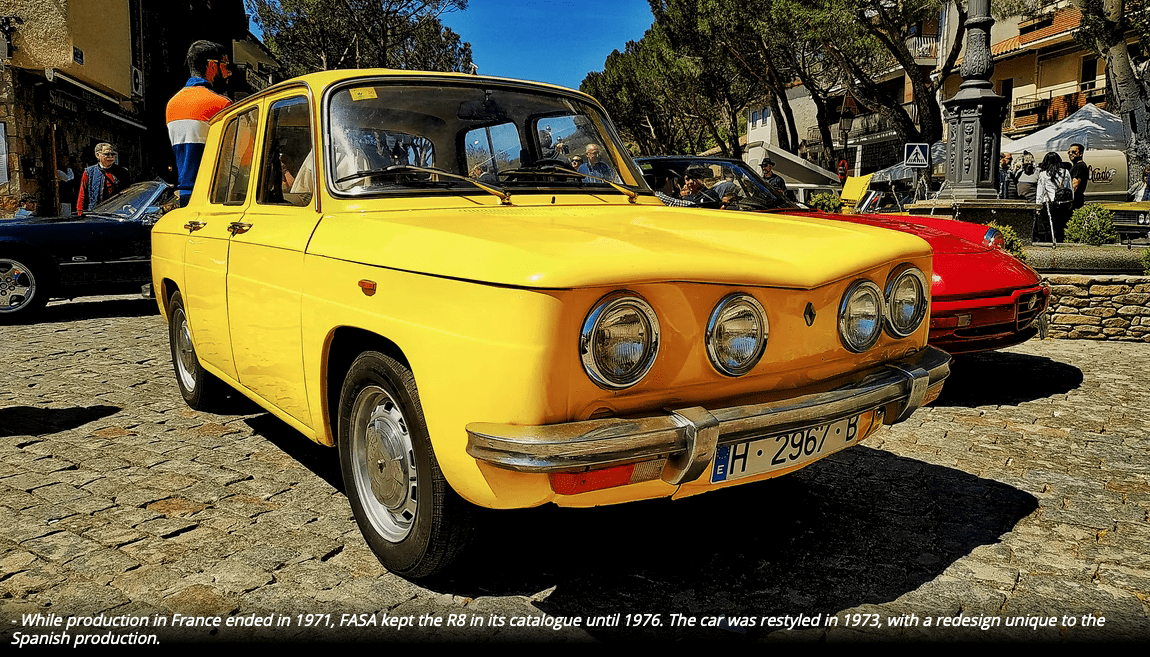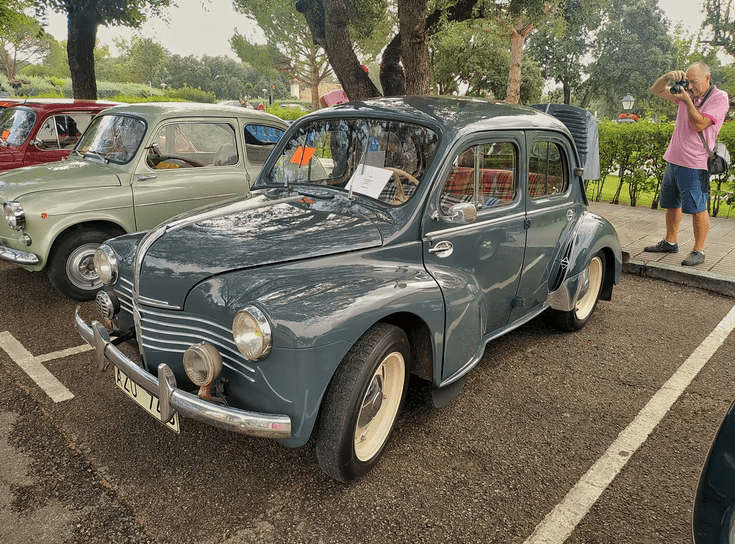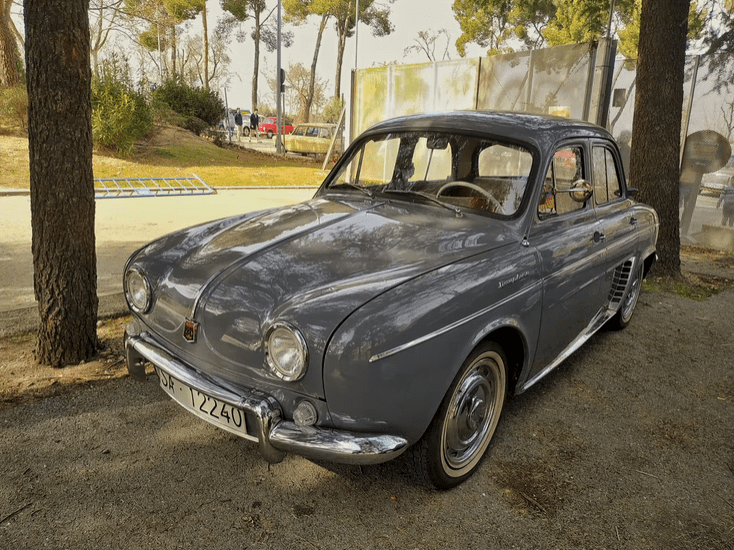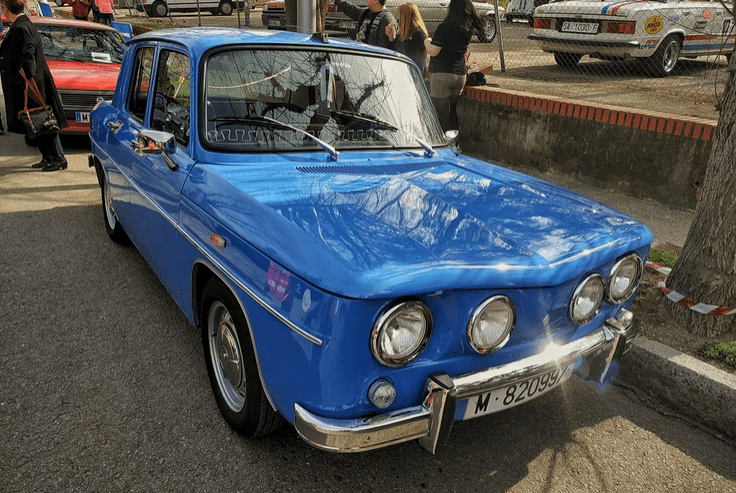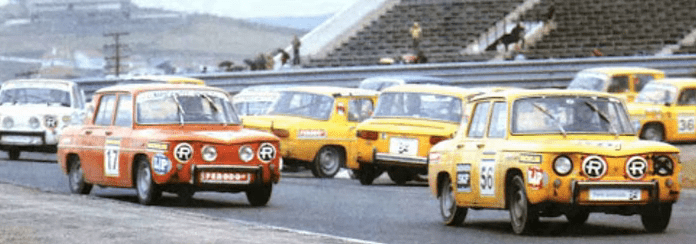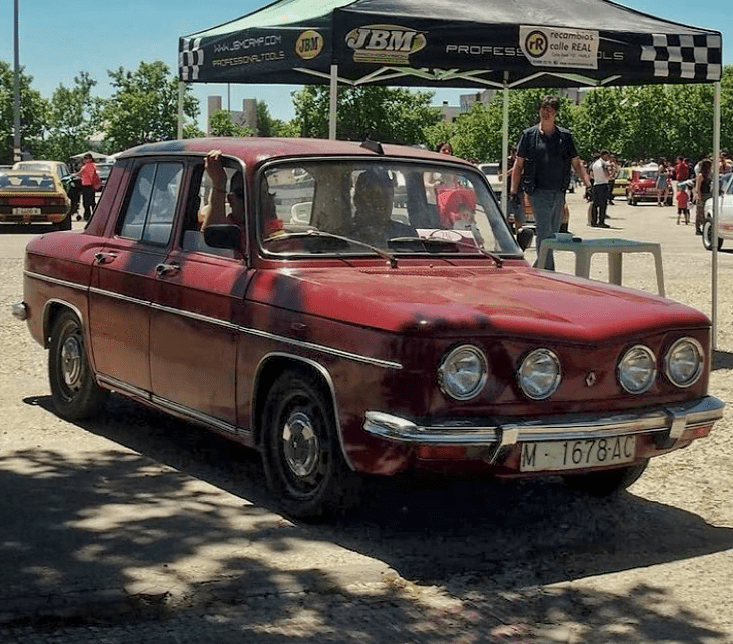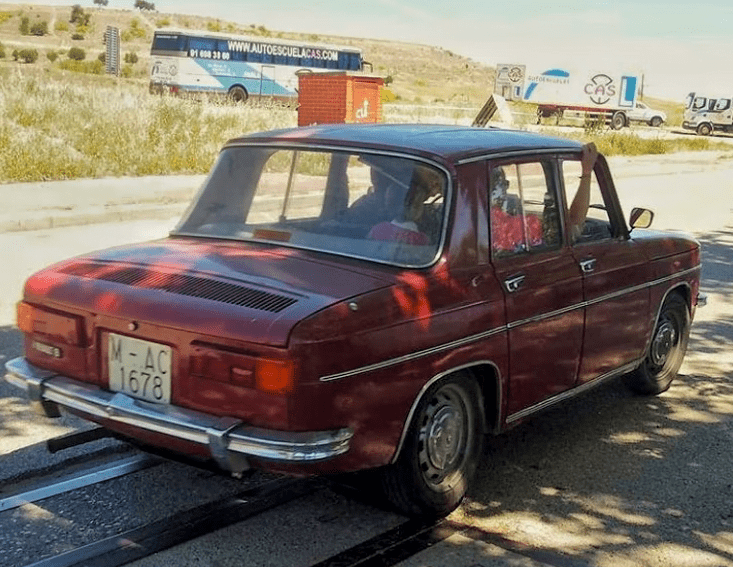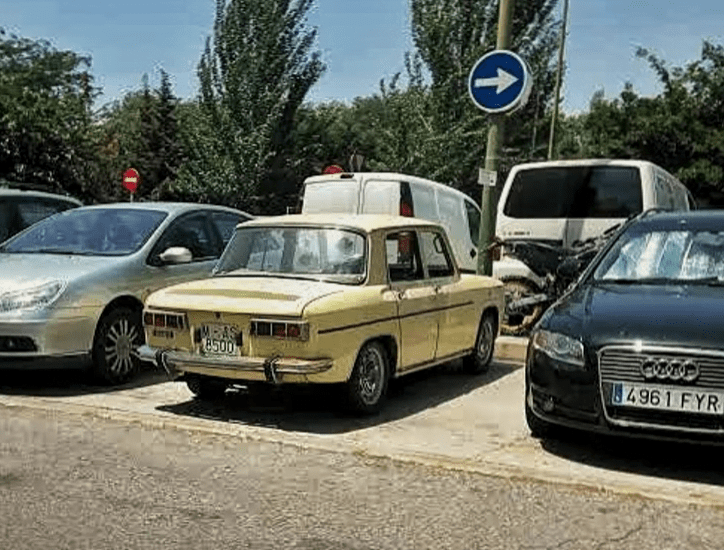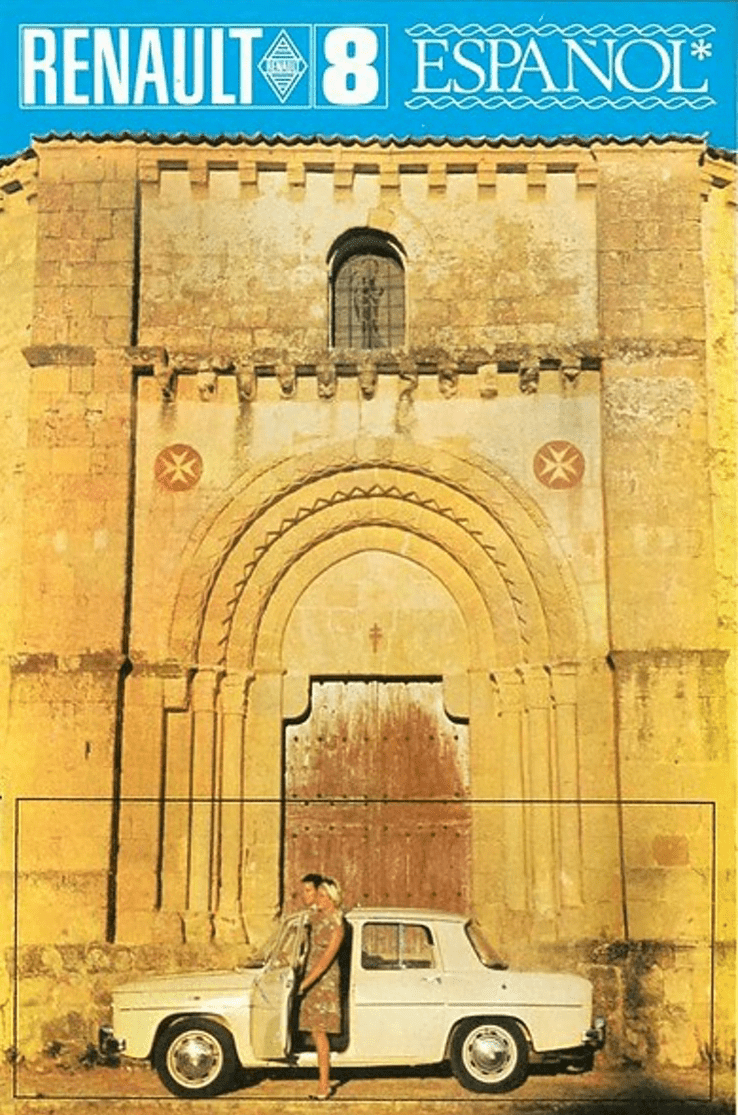Launched in 1965, the FASA Renault 8 was more than a comfortable family car. With the R8 TS, it became a key part in the Spanish motorsport history.
During the early 60’s, the automotive world was trying to find out what was going to be the hegemonic layout for the automobile in the future. The Morris Mini / Austin Se7en, launched in 1959, showed the world all the benefits of the transverse mounted front engine and front wheel drive: More space efficient, and much better road holding and driving quality. The FWD was, however, more expensive to build and more complex. At the same time, the rear engine and rear wheel drive layout was blooming as well. Easier and cheaper to build and design, it provided also a good interior space for the passengers, but most of those vehicles had cooling problems and were more difficult to drive under certain conditions.
Many manufacturers put their bets on the RR layout. Between 1959 and 1964, brands like FIAT (850), SIMCA (1000), Volkswagen (Type 3), NSU (Prinz IV), Rootes (Hillman Imp), BMW (700), Skoda (1000 MB) or Hino (Contessa) launched rear engine small or midsize cars. Even the most powerful motor company in the world, General Motors, launched a compact, for the American size perception, rear engined vehicle: The ill fated Chevrolet Corvair.
The Renault 4CV was the first post war Renault model. And the first rear engine car of the company, a kind of layout that would yield a lot of success during the following decades
Nevertheless, if there was a manufacturer that was convinced of the use of the RR layout, it was, apart from Volkswagen, Renault. Owned by the French government since the controversial nationalization of 1945, most of its models were rear engined. In 1946, the Regie Nationale des Usines Renault (RNUR) launched the 4CV, a small four door rear engined, powered by a 767cc engine and developed during World War II. The small, affordable and pretty little Renault was a success in Europe, but also was key to put Japan and Spain on wheels. In the U.S., however, was a failure.
The 4CV was followed in 1956 by the Dauphine. Mostly an evolution of the former, the Dauphine and the luxurious Ondine and the sporty Gordini siblings, became the backbone of the Renault range all across the world from the mid-fifties until the mid-sixties. The little sedans, featured a gorgeous rounded four door body, that was moved by an evolution of the Ventoux engine used on the 4CV. The 845cc unit now developed 28hp or 36hp on the model tuned by Amédée Gordini.
The Dauphine was a key product for Renault, as it was the vehicle RNUR wanted to use to conquer USA in a market not yet dominated by the Beetle. Also, it was the base for the first sports cars launched after the War, the Floride / Caravelle and the Alpine A108.
The Dauphine was key on the Renault expansion strategy during the fifties and sixties.
While the Dauphine failed to conquer the American market, forcing Renault to retreat from the other side of the ocean, it became a true worldwide car, built not only in France, but also in Italy (by Alfa Romeo!), Spain, built by FASA, Brazil, built by Willys, Argentina, Built by IKA, and was also assembled in Australia, New Zealand, Israel, Mexico or Belgium.
However, the Dauphine was far from perfect: Its engine was underpowered, and the stability was problematic. The “Aerostable” suspension, offered as an option starting in 1960, didn’t solve the problem, and by then Renault was working on its replacement.
1962: RNUR launches the Renault 8
The new boxy Renault 8, was a step ahead over the Dauphine
By the early sixties, the Dauphine star was starting to fade quicker than expected. The reason was probably its reputation, tarnished by the failure in the US, where some stock units were left to rot at the warehouses due to low sales until they were repatriated some time later. The dubious stability of the car didn’t help either. New competitors were ready to be released as well, and especially one, the SIMCA 1000, was a strong contender. Aware of its weakened market position, Renault began to develop a substitute that keeping the RR layout, could be able to address most of the problems of the Dauphine.
Designed in house by Gaston Juchet and Philippe Charbonneux, and developed in record time, RNUR launched its new model in June 1962: The Renault 8, or Renault R8 as it was known for the first two model years. The R8 featured a new engine, named “Cleon Fonté” by Renault and that had been introduced months ago in the sporty Floride S. It had a displacement of 956cc and developed 40hp, 30% more power than the Dauphine and 12% more than the Gordini. With that engine, the R8 was able to reach 130 km/h. The rear suspension was also modified, notably improving the Dauphine stability issues. It also introduced a novelty never seen in a car of its category: Four disc brakes.
The Renault 8 also looked more modern, featuring a boxy body, that seemed to be inspired in the Alfa Romeo type 103, especially the vee shaped bonnet. The R8 was longer and taller than the Dauphine, but was marginally narrower. The interior space was, however, superior on the new model.
The Renault 8 was introduced to the international press in Madrid in May 1962, and rumours about FASA building it locally began almost immediately. However, the R8 took a bit of time to arrive to the Valladolid assembly line.
¡Atención! ¡Frenos de disco!: The Renault 8 arrives to the Spanish market.
Apparently an exact copy of the French model, the FASA Renault 8 had many differences with its trans-pyrenean brother.
1965 was a key year for FASA. That year, FASA and RESA (Renault España S.A.) merged. Until then, both were independent companies, with FASA building the cars and RESA distributing and selling them, but in March 1965 both companies formed FASA Renault, with RNUR now owning 49% of the stocks. That would prove to be very important for FASA, as it went from just a licensee to become an industrial partner for RNUR.
After many months of waiting, in December 1965, the first Renault 8 rolled off the FASA assembly line. Despite looking almost exactly like a RNUR 1964 R8, the Spanish car had a notable difference: for cost reasons, the rear discs used on the French model were replaced by drums. In the other hand, the FASA product had a fully synchromesh four speed gearbox, unlike the earlier French models, that were available with three or four speed and with no synchromesh first gear.
The FASA Renault 8, despite losing the ones on the rear axle, was the first Spanish production car with disc brakes, and the first units proudly displayed a sticker on the rear screen that read “¡Atención! Frenos de disco (Warning! Disc brakes). Priced at 108900 Pesetas (Around 17000€ today) the Renault 8 became the first true middle class car built in Spain.
“It’s more of a car!” was the catchphrase used by FASA Renault to make clear that the Renault 8 was superior to its two main rivals: The Barreiros Simca 1000 and the SEAT 850
After 2017 units built in month and a half in 1965, 1966 was going to be the first full sales year for the FASA Renault 8. During that year, its two main rivals were going to be launched: the Barreiros SIMCA 1000 in January and the SEAT 850 in April. Both of them were rear engine models, similarly priced, with similar displacement engines and around the same power level. The 850 became a more serious rival once the two four door versions were launched in 1967. To make clear the (supposed) superiority of its product, FASA Renault used the slogan “¡Es mas coche!” (“It’s more of a car!”) in all Renault 8 related advertising material. And it worked, as the customers perceived the R8 as a better car than its rivals. Something helped by the fact that until the launch of the R8 derived Renault 10 in late 1966, the Renault 8 was the FASA top of the range.
In 1967, FASA refreshed the Renault 8 for the first time. While the exterior remained untouched, the interior adopted the Renault 10 seats, more comfortable and luxurious than the ones used before, and the dashboard gained a wood imitation fascia and air vents taken from the R10 as well. That made this version of the Renault 8, still available in just a single version unlike in France, unique for Spain.
Nevertheless, the true revolution was going to arrive, as it happened in many other aspects in life, in 1968.
A race car for everybody: The FASA Renault 8 TS
The Renault 8 TS became the first sports sedan built in Spain. It was an absolute game changer.
While in France, the Renault 8 evolved fast, abandoning the 956cc engine in 1966 and launching two sports versions, the Gordini and the Gordini 1300, in Spain the R8 remained as an unique model until October 1968.
That month, FASA launched the Renault 8 TS, inspired in the French Renault 8 S, launched just two months before. The R8 TS featured a 1108cc engine, the same used on the Renault Caravelle, that developed 56hp, 16 more than the normal version. That engine allowed the R8 TS to achieve 145 km/h, a more than respectable figure for a mid size family car. The TS also featured a four-lamp front end, sport seats finished in leather and fabric, a new dashboard with extra instruments and a different steering wheel. Unlike the Renault 8 standard available in a great variety of colours, the TS was only available in blue, yellow and orange.
Family car Monday to Friday, race car on weekends.
Priced at 140400 Pesetas (Around 19000€ today) the Renault 8 TS was fast, affordable and became the first sports sedan ever manufactured in Spain. Since its launch, every weekend many motor fanatics raced their TS in different amateur circuit races or local rallyes. FASA, aware of that, had an idea that in the end, changed the Spanish motorsport forever.
More than a car, a race driving school. The Copa TS is born.
Looking at the condition of the cars, we can clearly see the races at the Copa TS were not exactly relaxed.
For many years, motorsport in Spain was reserved for the elite. For example, one of the most renown Spanish racing drivers from the fifties and the first one to drive a Ferrari in a Formula 1 grand prix, the ill fated Alfonso de Portago, was an aristocrat, Count of Portago and Marquis of Mejorada. Like him, other great racing drivers of that era, like Jorge de Bagration, Julio Gargallo or Juan Fernández were aristocrats or wealthy entrepreneurs who could afford to import the best machines available: Alfa Romeo, Porsche, Lancia… that made them unbeatable.
That was a problem, as there were a great amount of young racing drivers that couldn’t show their potential, as they could not afford such machines. And therefore, they could not develop all their skills to become professional racing drivers.
FASA, was aware of that situation, and in 1969, was going to change it forever. Taking advantage of the Renault 8 TS popularity, FASA and the Spanish Motorsport Federation reached an agreement to develop and launch the first single-model championship ever held in Spain.
Too many angry R8s, too little space.
Inspired by the success of similar championships held in France or Brazil, FASA and the Federación Española de Automovilismo designed a championship with simple, but clear rules: All the drivers would drive the same car, a street legal Renault 8 TS, only modified with safety features like roll cages and some experienced drivers were banned to enter the competition.
With those rules, the “Copa TS”, as the event was called, became a true racing driver’s school, as all them were driving the same vehicles, under the same specifications and only their skills would decide the winner of each race.
The races were absolutely spectacular, with up to 35 Renault 8 TS fighting, in some cases literally, for the victory in racing circuits like the Jarama, but also in street circuits like Alcañiz.
Not as glamorous as Montecarlo, but the urban circuit of Alcañiz saw some of the fiercest battles of the Copa TS
The success of the Copa TS in 1969 was absolute, and the event was held again in 1970, where some rally races were also included. The Copa TS would be held without interruption until 1976, when the Renault 8 was finally discontinued, but the game had already changed. Even if the following editions were held using different models, like the Renault 5 Copa or the Renault 5 GT Turbo, the imprint left by the Copa TS was impossible to erase. Renault made the motor racing affordable and thanks to the bravery of FASA organizing such event, a generation of excellent Spanish racing drivers, like Salvador Cañellas, “Correcaminos” Sornosa, Zapico or Villacieros was born, changing the face of the Spanish motorsport forever. And many more came after them using the path opened by the small sport sedan. Quite an achievement for the R8 TS.
The golden years: production record and exports.
In 1972, the whole range received the four headlight front end, exclusive for the TS until then
The early 70’s were the golden years for the Spanish Renault 8. the “Erre Ocho” was the best selling car of the whole FASA range and production kept increasing. In 1970, almost 35000 cars left the factory, while in 1971 were more than 39000. The Renault 8 was regarded as one of the best cars built in Spain in terms of quality and reliability, and sales reflected it.
The car evolved slowly. A new interior was added in 1971, with a new instrument panel, similar to the one of the 8 TS but without rev counter and oil pressure dial. Also the seats were renewed, featuring now leatherette sides and the steering wheel was also renewed, featured now a padded center. In September 1972, the Renault 8 received the four headlamp front end in the whole range, as well as new wheels and hubcaps.
Even more important was the rise of exports. With production at the Flins plant ending in 1971, from there and until 1973, when RNUR discontinued the Renault 8 in Europe, the European markets received FASA built vehicles. It was not the only export destination for the FASA sedan: The R8 built at the Mexican plant in Ciudad Sahagun, were made out of Spanish CKD kits as well.
Revalorizado: The Spain-only final restyling.
While the car was discontinued in Europe as the demand for rear engine cars dwindled, the Renault 8 was still a good seller in Spain. FASA kept the model alive until 1976
The seventies was a time of change in the automotive world. The oil crash of 1973, killed the gas guzzlers and muscle cars, and manufacturers focused on small and fuel efficient cars. Also, the front wheel drive cars became majority in the small and medium car segment. That meant the end of the rear engine cars, that were discontinued slowly, but without a pause along the de decade.
The Renault 8 was some kind of dinosaur in the European Renault range by 1973. All the rest of the models, except the Alpine, were front wheel drive. However in Spain, in a market still over protected by the government, the choices were limited and the Renault 8 was still a “safe value” as FASA called it on the advertising material.
So, in May 1973, and while preparing the launch of the R8 forthcoming substitute, the Renault Siete, FASA launched a unique restyling for the Renault 8.
This rear end received changes as well, although not as deep as the ones on the front end.
Available in both standard and TS versions, with the 956 and 1108 cc engines developing the same outputs as the old models, the new Renault 8 “Revalorizado” as FASA called it, received a new front end featuring a new, flat bumper, four headlights and new rectangular indicators, now positioned under the bumper. The wheels were new with a new design and a new size of 14 inches. The hubcaps were also new, similar to the ones used on the Renault 5 950. The rear end received a new bumper as well and new, bigger trapezoidal tail lights. The interior got new seats, very similar to the ones used on the Renault 5, with reclinable backrests as an option.
The Renault 8 TS received also two new colours: White and lemon green, although both were very rare.
The Renault 8 TS was also available in this second series, although not many were built.
Very few changes were made to the renewed Renault 8. In 1974, for the 1975 model year, the car received new rubber guards for the bumpers and a new steering wheel, with a bigger padded area. By then, sales began to diminish in Spain too, and when FASA launched the Renault Siete in late 1974, the Renault 8 was doomed.
The figures are crystal clear: In 1973, 25989 R8 and 1026 R8 TS were built. In 1974, the last sales year before the Siete, the production was 21372 R8 and 881 R8 TS.
In 1975, with the demand dwindling and the Siete on the market, only 11133 R8 and 498 R8 TS rolled off the assembly line. It was clear that the time for the glorious rear engined Renault, had come.
1976 was the last production year for the FASA R8. 3352 R8 and just 49 R8 TS were built until June, when production finally stopped. That day, FASA not only said farewell to its most succesful product until then. It also said goodbye to a car that had become a legend.
259547 cars were built in eleven years, with almost 10000 of them exported. Those figures meant quite a success back then, in a time before the Ford decreets where exports were not as big as they became later in the decade.
Epilogue
The Renault 8 was part of the Spanish landscape until the 90’s.
FASA was founded in 1951, and with the 4/4 and the Dauphine range, got a moderate success. It was however, the Renault 8 the car that definitely turned it into a serious contender for SEAT.
Born as a compact family sedan, the launch of the Renault 8 TS in late 1968 changed the image of the car and the Spanish motorsport forever. The Copa TS became the best racing school any young driver could image, and with it, motorsport was no longer a sport for the wealthy elites.
The R8 was a common sight on the Spanish streets for many years. Its building quality and legendary reliability kept them as daily drivers well into the 90s. After that, the age and the government scrapping schemes thinned the number of survivors quickly. By the early noughties it finally earned the cult classic car status it always deserved.
Its awesome how a car, that by the end of its commercial run was seen as vestige of the past, could have changed the Spanish motor scene so deeply. Kudos to the little Renault!.

